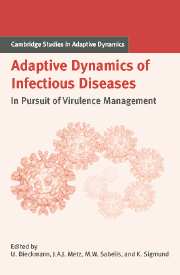Book contents
- Frontmatter
- Contents
- Contributing Authors
- List of Boxes
- Notational Standards
- 1 Introduction
- A Setting the Stage
- B Host Population Structure
- C Within-Host Interactions
- D Pathogen–Host Coevolution
- Introduction to Part D
- 13 Coevolution of Virus and Host Cell-death Signals
- 14 Biogeographical Perspectives on Arms Races
- 15 Major Histocompatibility Complex: Polymorphism from Coevolution
- 16 Virulence Management and Disease Resistance in Diploid Hosts
- 17 Coevolution in Gene-for-gene Systems
- 18 Implications of Sexual Selection for Virulence Management
- 19 Molecular Phylogenies and Virulence Evolution
- E Multilevel Selection
- F Vaccines and Drugs
- G Perspectives for Virulence Management
- References
- Index
- International Institute for Applied Systems Analysis
17 - Coevolution in Gene-for-gene Systems
Published online by Cambridge University Press: 15 January 2010
- Frontmatter
- Contents
- Contributing Authors
- List of Boxes
- Notational Standards
- 1 Introduction
- A Setting the Stage
- B Host Population Structure
- C Within-Host Interactions
- D Pathogen–Host Coevolution
- Introduction to Part D
- 13 Coevolution of Virus and Host Cell-death Signals
- 14 Biogeographical Perspectives on Arms Races
- 15 Major Histocompatibility Complex: Polymorphism from Coevolution
- 16 Virulence Management and Disease Resistance in Diploid Hosts
- 17 Coevolution in Gene-for-gene Systems
- 18 Implications of Sexual Selection for Virulence Management
- 19 Molecular Phylogenies and Virulence Evolution
- E Multilevel Selection
- F Vaccines and Drugs
- G Perspectives for Virulence Management
- References
- Index
- International Institute for Applied Systems Analysis
Summary
Introduction
Gene-for-gene (GFG) systems are genotype-specific, antagonistic interactions between hosts and parasites, widely observed in plants and their microbial parasites (Burdon 1987). Detailed studies on crop plant and fungus pathogen systems have revealed that when breeders introduce resistant hosts, a rapid evolution of parasite virulence occurs that overcomes the resistance. This process suggests a continuous coevolutionary change in both host and parasite. The spread of a resistant genotype capable of escaping a currently prevalent parasite will be challenged by a new parasite strain that harbors a virulent gene, capable of overcoming that resistance. Similarly, a host with a new resistant gene, possibly at another locus, would be able to restore resistance against the same parasite. Besides its importance in agriculture and biological control, GFG interactions play a key role in models of host-parasite coevolution. These models reveal a robust tendency toward protected polymorphisms and sustained cycles of host and parasite genotypes, which, in turn, favor higher rates of mutation, recombination, and sexual reproduction (e.g., Hamilton 1980; Hamilton et al. 1990; Frank 1993b; Haraguchi and Sasaki 1997).
From the perspective of virulence management, one consequence of the modeling approach described in this chapter is of potential practical importance: the results presented here reveal a wide parameter range in which polymorphism of host resistance can prevent the spread of any virulent strain of parasite and maintain a disease-free host population.
- Type
- Chapter
- Information
- Adaptive Dynamics of Infectious DiseasesIn Pursuit of Virulence Management, pp. 233 - 247Publisher: Cambridge University PressPrint publication year: 2002



